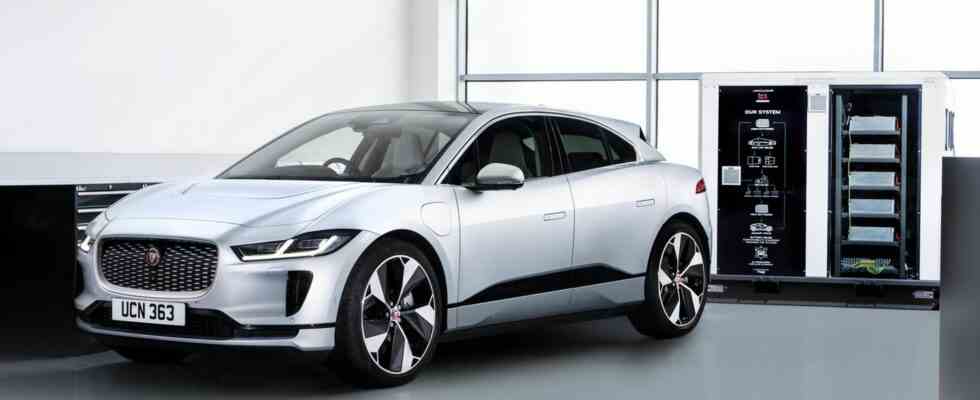Second Life Battery
Jaguar Land Rover turns old batteries into green power storage systems
A climate-friendly power storage system is being made from old Jaguar car batteries
©Jaguar Land Rover
The battery of an electric car loses its energy content after a few years. But what to do with old batteries? Jaguar Land Rover, in cooperation with the energy company Pramac, has developed a green energy storage system that uses old batteries from electric cars.
As with all electronic devices, batteries in electric cars lose their full capacity after a few years. They are then no longer suitable for driving, but they do not have to be disposed of immediately. A new power storage device from Jaguar Land Rover and the energy company Pramac shows that the batteries can be used in a so-called second life.
The two companies have jointly developed a system of lithium-ion battery cells for the Jaguar I-Pace model. The battery cells with a state of charge of less than 70 percent should be able to store energy. This should be emission-free, because the energy used comes from solar cells.
François Dossa, Executive Director, Strategy and Sustainability at Jaguar Land Rover says it is “proof that it is possible to generate zero-emission electricity by combining renewable energy and second-life batteries”.
Mobile power storage as an energy source
The power storage system with a capacity of up to 125 kWh could be “safely used in numerous low-energy situations,” says Jaguar Land Rover. Accordingly, it should be possible to rent it for commercial purposes. It has type 2 charging connections for electric vehicles and an output of up to 22 kW AC. The system is enough to fully charge an I-Pace or to power a standard British family home for a week.
Jaguar Land Rover had already used the storage system during preparation for the 2022 Formula E World Championship. It is said to have helped run the team’s diagnostic equipment during tests in Valencia to analyze the cars’ performance on the track. It also supplied the Jaguar pit garage with auxiliary power. The carmaker plans to use the power storage in future in the “Experience Center” in Johannesburg to support the power supply there. The company also announced that it intends to start further programs in the future to give old batteries a second life.
Increasing use of second-life batteries
However, the use of second-life batteries is not new. Recycling companies and car manufacturers are now increasingly using the process. The German-Indian start-up Nunam, for example, is converting old batteries from the Audi e-tron into battery storage systems with a system capacity of 5 kWh as part of a pilot project. They charge electricity from solar energy and are used in India, for example to supply electricity to a street.
Old batteries from the Audi e-tron are also used in an energy storage facility in Herdecke, North Rhine-Westphalia. Together with RWE, Audi has put an energy storage facility into operation on the RWE site, which is intended to temporarily store around 4.5 megawatt hours of electricity with the help of 60 battery systems. “Depending on how they are used, the batteries still have a lifespan of up to ten years,” he says Audi with.
Volvo, for example, is working with Swedish recycling company BatteryLoop to develop solar-powered energy storage systems from old Volvo car batteries. In addition, the Swedish carmaker is working with the Swedish cleantech company Comsys AB and the energy company Fortum on a pilot project in which old batteries from Volvo plug-in hybrid cars are used as stationary energy storage devices.
The Middle Franconian electricity provider N-Ergie has been operating an electricity storage facility in Wendelstein near Nuremberg since 2019. This consists of around 100 battery modules from Audi models and has a maximum feed-in and feed-out capacity of 500 kilowatts. According to the company, the storage capacity could supply around 100 households with electricity for a day.
In 2016, Mercedes commissioned what they claim to be the world’s largest battery storage facility from old e-car batteries in Lünen. The 13 MWh battery storage consists of a total of 1000 batteries from Smart Fortwo models, the energy from which should flow into the German energy market.
BMW and the energy group Vattenfall also announced in September 2018 that the two companies, in cooperation with Bosch, had developed an electricity storage system in the port of Hamburg for a test. The system, with a storage capacity of around 2.8 megawatt hours, uses old batteries from the Active E and BMW i3 electric car models and, according to its own statements, could supply an average two-person household with electricity for seven months. However, it serves to compensate for fluctuations in the power grid. In Amsterdam, BMW and Vattenfall have also built such an electricity storage system.
Swell: Jaguar Land Rover, Audi, Vattenfall, Mercedes Benz, daily News, N-ergy, Volvo

